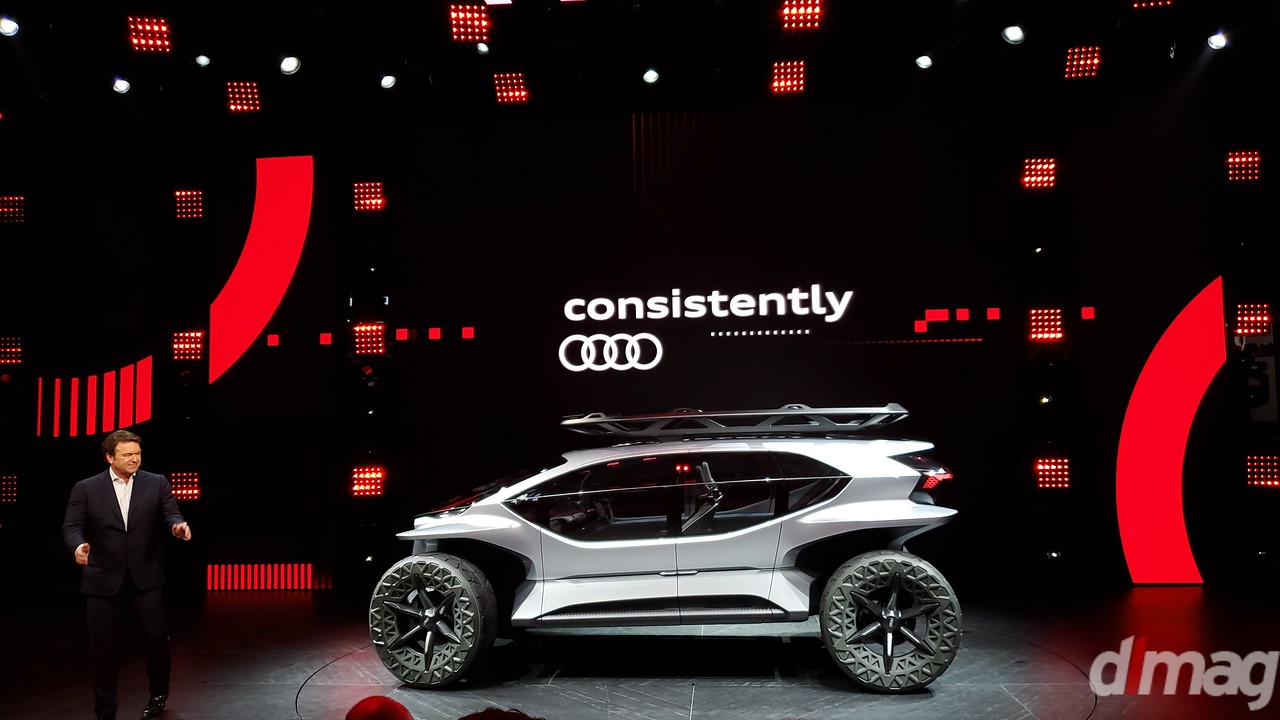Audi is making a huge impression at the 2019 Frankfurt Motor Show with the AI:Trail Concept SUV – and for good reason. The brand is on the verge of change, and it wants to put the whole dieselgate scandal behind by looking towards an electrified and sustainable future. In fact, the German carmaker is on a path to launch thirty electric models by 2025, with twenty of them boasting an all-electric, zero-emissions power unit and drivetrain.
The AI:Trail is the fourth concept to wear the AI badge
We weren’t surprised when Audi unleashed the firepower in Frankfurt. Taking center stage was the Audi RS7 Sportback and the new RS6 Avant. Both cars have a 600-horsepower turbocharged V8 motor, eight-speed transmission, and Quattro all-wheel drive.
However, both the RS7 Sportback and RS6 Avant are mild hybrids. Both vehicles have a belt alternator starter motor that harvests electrical energy as you squeeze the gas pedal. The electrons are stored in a small battery pack and are utilized to power the stop-start and coast functions of the car.
Apparently, Audi at Frankfurt is about turning a new chapter in the company’s storied history. Part of this are four new concept cars that symbolize the future of the Audi brand. One of these is the AI:Trail Quattro Concept SUV. It looks like it came from the moon and crashed directly into Earth. It’s part SUV and part Sci-Fi movie, and we love it when concept cars make us feel like kids all over again.
Audi also previewed the AI:Race, which is essentially an electrified version of the R8 supercar and debuted at Pebble Beach in 2018. In the meantime, the Aicon is a fully autonomous luxury sedan for long-range journeys. The AI:Me shares a similar footprint with the AI:Trail and is meant to be a small car-like SUV for city driving.
It’s almost the same size as the Audi Q3
Truth be told, the AI:Trail Concept and the Audi Q3 are similar in length, but the former has a longer wheelbase. It’s also as wide as the Q7 full-size SUV and has 34cm of ground clearance. In short, the AI:Trail is a large four-seat, four-door SUV capable of fording rivers half a meter deep. The go-anywhere stance means you can transition from tarmac to gravel and mud without skipping a beat.
The AI:Trail is equipped with four electric motors
First and foremost, Audi’s AI:Trail Concept is engineered to handle the rough stuff, and it needs loads of power to do so. It has four electric motors – one in each wheel – producing a collective output of 429-horsepower and 738 pound-feet of torque. This gives you more than enough power to go overlanding on a mountain range.
Audi didn’t say much about battery capacity and charging options, but we know the AI:Trail has an estimated range of 249 miles on tarmac and around 155 miles over dirt roads.
It has no headlights, but it comes with a fleet of drones
Didn’t we say the Audi AI:Trail came from a Sci-Fi world? The car has no conventional headlights. With all the glass panels in the front and around the vehicle, Audi has no place to shoehorn some awkward-looking headlights. Instead, the AI:Trail relies on a fleet of five drones that fly ahead to illuminate the vehicle’s path. Yes, it sounds ridiculous and absurd, but so did the airbag and seatbelts before they were invented. The drones employ from the roof of the vehicle to offer better illumination in the darkest of nights. If this makes it into production, the AI:Trail is going to be one hell of an SUV.
The AI:Trail is an autonomous car
Audi said the AI:Trail is equipped with Level 4 autonomy, but it has the ability to engage Level 3 autonomy at slow speeds or when off-roading. But with those intimidating 22-inch wheels and 33.5-inch off-road tires, why let artificial intelligence have all the fun? The Audi AI:Trail is very much designed to be driven, but it’s good to know the car can take over if you want to take a break from all that overlanding and off-roading stuff.
The Audi AI:Trail is essentially a lifted four-door dune buggy with huge wheels and expansive glass canopies. Can you see yourself driving this vehicle in the near future?
*Vincent Nguyen contributed to this story
